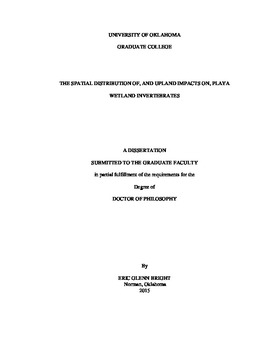| dc.description.abstract | Playa wetlands are a type of temporary wetland that are numerous in the Great Plains of the United States. Playa wetlands offer a unique habitat within semiarid grassland ecosystems. My research on the invertebrates of playa wetlands centered on two topics: (1) the distribution of invertebrates in and around playa wetlands and (2) whether playa resident invertebrates are affected by the surrounding landscape (sediment movement from uplands into wetlands).
In the first chapter, I examined whether the invertebrate community of the uplands influences the dry playa wetland invertebrate community. I used colored pan traps, pitfall traps, and aerial insect traps to sample the invertebrates within dry playas and in their surrounding uplands. There was no difference in abundance, richness, or overall community composition among flying insects captured with aerial traps between upland and dry wetland habitats. Invertebrates captured in colored pan traps (which tend to catch insects attracted to flowers), differed from upland to playas in abundance, but the overall invertebrate community was similar between locations. The pitfall traps, which tend to catch ground-dwelling invertebrates, showed similar invertebrate abundance and richness but different invertebrate composition between playa and upland. The invertebrates of the dry playas showed a high degree of nestedness within the upland assemblage. However, because of soil size composition and vegetational differences, some taxa (i.e. ants, thrips, megachilids) were better adapted to either the dry playa wetland or the surrounding uplands. Therefore, protecting playa wetlands will help conserve two distinct invertebrate communities, the dry playa and terrestrial communities.
The second chapter covers a survey of the location of aquatic invertebrate resting stages within playas and the surrounding uplands. I collected two soil cores from the surrounding uplands, at the edge, and in the center of the playa from four playa wetlands in western Oklahoma, United States. The soil cores were rehydrated in a greenhouse for two weeks under ambient temperature and light. Data from two soil cores from each location (i.e. upland, edge, and center) within each playa were pooled. Invertebrate richness, abundance, and overall community were calculated for each location. Aquatic taxa richness and abundance were higher in the center and edge locations than the upland locations. The overall invertebrate communities of the wetland soil and upland soil differed from each other while the edge community shared characteristics of both the upland and wetland communities. The differences in resting stages were likely due to environmental and behavioral factors that concentrate the resting stages into the center of the playa wetland. Therefore, the center of playa wetlands is probably the most critical area for conserving aquatic taxa species richness and abundance.
The third chapter deals with conservation issues involving uplands and wetlands. Here, I examined whether the resident invertebrate community was susceptible to landscape effects in the form of sedimentation and also considered a mechanism that may cause a decrease in invertebrate hatching from added sedimentation. Soil collected from four playas was homogenized to account for differences in invertebrate communities across locations within the playa. Sterilized upland soil of three different depths (0.25 cm, 0.5 cm, and 1.0 cm) was added on top of playa soil, and a fourth control treatment had no added sediment. The soil was rehydrated for two weeks under a 12:12-hour light:dark regime at room temperature. Sedimentation affected invertebrate hatching, with the addition of 0.5 or 1.0 cm of sediment decreasing invertebrate hatching. Because sediments affect light attenuation, I examined whether light was a necessary cue for invertebrate hatching. To do so, I rehydrated homogenized soil under three light treatments (24-hour light, 12:12-hour light:dark, and 24-hour dark regimes). Very few invertebrates hatched in the dark; hatching was greater in the lighted treatments, with no differences between the 12:12-hour light:dark and 24-hour light treatments. Finally, I examined whether buried invertebrate resting stages could hatch if exposed to the correct environmental cues. I collected two soil cores from the center of each of the four playa wetlands and divided the soil cores into three different soil levels (0-2 cm, 2-5 cm, and 5-20 cm). The soil levels were rehydrated for two weeks in environmental chambers (12:12-hour light:dark regime at 25°C). There were more invertebrates in the two top layer of soils (0-2 cm and 2-5 cm) than the 5-20 cm layer. However, some invertebrates hatched from deeper layers, so some buried crustaceans can hatch when exposed to the correct environmental cues. Sedimentation affects invertebrate hatching from playa wetlands, in part by limiting light reaching the invertebrate resting stages. Buried resting stages can hatch even after sedimentation, once they are exposed to the correct environmental cues. Thus, sedimentation may be of great concern to playa wetlands conservation because overlaying sediment affects crustacean hatching, which might cause a decrease in invertebrate prey for higher trophic levels. | en_US |
